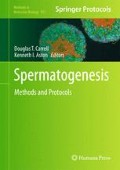Abstract
Proteomics is the study of the proteins of cells or tissues. Sperm proteomics aims at the identification of the proteins that compose the sperm cell and the study of their function. The recent developments in mass spectrometry (MS) have markedly increased the throughput for the identification and study of the sperm proteins. Catalogues of spermatozoal proteins in human and in model species are becoming available laying the groundwork for subsequent research, diagnostic applications, and the development of patient-specific treatments. A wide range of MS techniques is also rapidly becoming available for researchers. This chapter describes a methodological option to study the sperm cell using MS and provides a detailed protocol to identify the proteins extracted from a Percoll-purified human sperm population and separated by two-dimensional polyacrylamide gel electrophoresis (2D-PAGE) using LC-MS/MS.
Access this chapter
Tax calculation will be finalised at checkout
Purchases are for personal use only
References
Domon B, Aebersold R (2006) Mass spectrometry and protein analysis. Science 312:212–217
Cox J, Mann M (2007) Is proteomics the new genomics? Cell 130:395–398
Aebersold R, Mann M (2003) Mass spectrometry-based proteomics. Nature 422:198–207
Brewis IA, Gadella BM (2010) Sperm surface proteomics: from protein lists to biological function. Mol Hum Reprod 16:68–79
Oliva R et al (2009) Sperm cell proteomics. Proteomics 9:1004–1017
Baker MA, Aitken RJ (2009) Proteomic insights into spermatozoa: critiques, comments and concerns. Exp Rev Proteomics 6:691–705
Com E et al (2003) New insights into the rat spermatogonial proteome: identification of 156 additional proteins. Mol Cell Proteomics 2:248–261
Pixton KL et al (2004) Sperm proteome mapping of a patient who experienced failed fertilization at IVF reveals altered expression of at least 20 proteins compared with fertile donors: case report. Hum Reprod 19:1438–1447
Chu DS et al (2006) Sperm chromatin proteomics identifies evolutionarily conserved fertility factors. Nature 443:101–105
Dorus S et al (2006) Genomic and functional evolution of the Drosophila melanogaster sperm proteome. Nat Genet 38:1440–1445
Martinez-Heredia J et al (2006) Proteomic identification of human sperm proteins. Proteomics 6:4356–4369
Martinez-Heredia J et al (2008) Identification of proteomic differences in asthenozoospermic sperm samples. Hum Reprod 23:783–791
de Mateo S et al (2007) Marked correlations in protein expression identified by proteomic analysis of human spermatozoa. Proteomics 7:4264–4277
Baker MA et al (2010) Analysis of proteomic changes associated with sperm capacitation through the combined use of IPG-strip pre-fractionation followed by RP chromatography LC-MS/MS analysis. Proteomics 10:482–495
Oliva R, Dixon GH (1991) Vertebrate protamine genes and the histone-to-protamine replacement reaction. Prog Nucleic Acid Res Mol Biol 40:25–94
de Yebra L et al (1993) Complete selective absence of protamine P2 in humans. J Biol Chem 268:10553–10557
de Yebra L, Oliva R (1993) Rapid analysis of mammalian sperm nuclear proteins. Anal Biochem 209:201–203
Oliva R (2006) Protamines and male infertility. Hum Reprod Update 12:417–435
de Mateo S et al (2009) Protamine 2 precursors (Pre-P2), protamine 1 to protamine 2 ratio (P1/P2), and assisted reproduction outcome. Fertil Steril 91:715–722
Yoshii T et al (2005) Fine resolution of human sperm nucleoproteins by two-dimensional electrophoresis. Mol Hum Reprod 11:677–681
Oliva R et al (2008) Proteomics in the study of the sperm cell composition, differentiation and function. Syst Biol Reprod Med 54:23–36
de Mateo S et al (2011) Improvement in chromatin maturity of human spermatozoa selected through density gradient centrifugation. Int J Androl 34:256–267
de Mateo S et al (2011) Protamine 2 precursors and processing. Protein Pept Lett 18:778–785
de Mateo S et al (2011) Proteomic characterization of the human sperm nucleus. Proteomics 11:2714–2726
Castillo J et al (2011) Protamine/DNA ratios and DNA damage in native and density gradient centrifuged sperm from infertile patients. J Androl 32:324–332
Mengual L et al (2003) Marked differences in protamine content and P1/P2 ratios in sperm cells from percoll fractions between patients and controls. J Androl 24:438–447
Koppers AJ et al (2011) Phosphoinositide 3-kinase signalling pathway involvement in a truncated apoptotic cascade associated with motility loss and oxidative DNA damage in human spermatozoa. Biochem J 436:687–698
Acknowledgment
Supported by grants from the Ministerio de Educación y Ciencia (BFU2009-07118), fondos FEDER. The authors acknowledge the critical revision by Dr. Alexandra Amaral.
Author information
Authors and Affiliations
Corresponding author
Editor information
Editors and Affiliations
Rights and permissions
Copyright information
© 2013 Springer Science+Business Media, LLC
About this protocol
Cite this protocol
de Mateo, S., Estanyol, J.M., Oliva, R. (2013). Methods for the Analysis of the Sperm Proteome. In: Carrell, D., Aston, K. (eds) Spermatogenesis. Methods in Molecular Biology, vol 927. Humana Press, Totowa, NJ. https://doi.org/10.1007/978-1-62703-038-0_35
Download citation
DOI: https://doi.org/10.1007/978-1-62703-038-0_35
Published:
Publisher Name: Humana Press, Totowa, NJ
Print ISBN: 978-1-62703-037-3
Online ISBN: 978-1-62703-038-0
eBook Packages: Springer Protocols

